Vol. 7 No. 15 | Commercial Blue Crab Fishing in the Gulf of Mexico States
Authors
Your Extension Experts
Related News
November 7, 2014
October 3, 2014
July 18, 2014
According to Gulf FINFO (http://gulffishinfo.org/), blue crabs (Figure 1) “range from Nova Scotia and Maine to northern Argentina and are found throughout the Gulf. There are likely two different blue crab stocks in the Gulf: a Florida or Eastern Gulf stock along the Florida coast (centered around Tampa Bay) and a Western Gulf stock from central Texas to Apalachicola Bay (centered in Louisiana). Blue crab larvae are found in salty offshore waters. Post-larvae move into shallow, lower salinity estuarine waters. Juveniles remain in the upper and middle estuary in areas with marsh and sea grass, oyster reefs, as well as soft mud bottoms, all of which provide some protection from predators. As juvenile crabs grow larger, they move to fresher waters. Adult blue crabs are found on a variety of bottom types including submerged vegetation, unvegetated sediments, and marsh grass in fresh, estuarine, and shallow oceanic waters throughout the Gulf.”
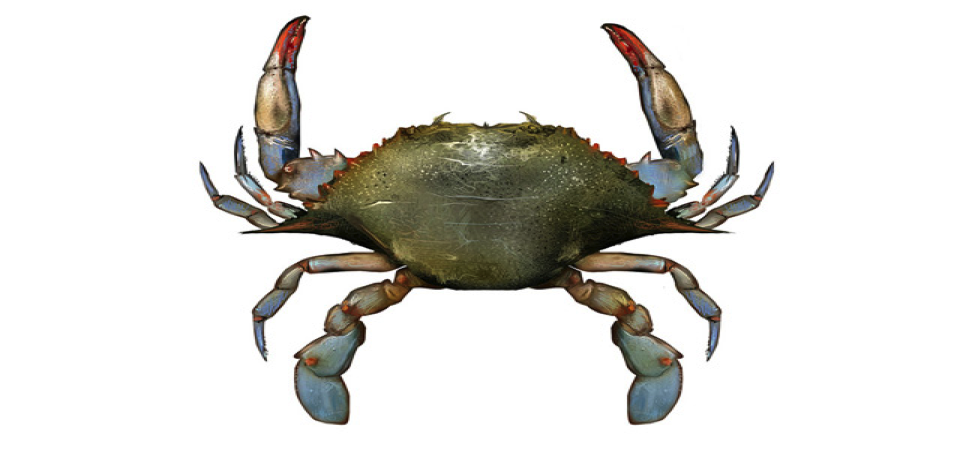
Economic impact analysis shows the economic contribution an industry makes locally, region-wide, nation-wide, or globally. This information is crucial in making private investment decisions, formulating government policy, and developing research and extension programs for the industry. The IMPLAN (http://implan.com/) software and the 2013 input-output data for the five Gulf States were used to estimate the economic contribution of blue crab commercial fishing to the Gulf of Mexico regional economy in 2015. The economic impact analysis used sector 17 or commercial fishing of the 2013 IMPLAN input-output data.
The IMPLAN economic model generates economic impact estimates regarding output or sales, employment or jobs, labor income, value added and tax revenues. The income, value-added, and output impacts are expressed in dollars for the year specified by the user. Output or sales are the gross sales by businesses within the economic region affected by an activity. Labor income includes personal income including wages and salaries and proprietors’ income or income from self-employment. Employment impacts are expressed in terms of a mix of both full-time and part-time jobs. Value-added is the contribution made to the value of seafood products at each stage of harvesting, processing, and distribution.
The total economic impact is the sum of direct, indirect and induced impacts. The direct effects express the economic impacts in the sector in which the expenditure was initially made. Indirect effects result from changes in the economic activity of other industrial sectors which supply goods or services to the commercial fishing industry. Induced effects are the product of personal consumption expenditures by industry employees.
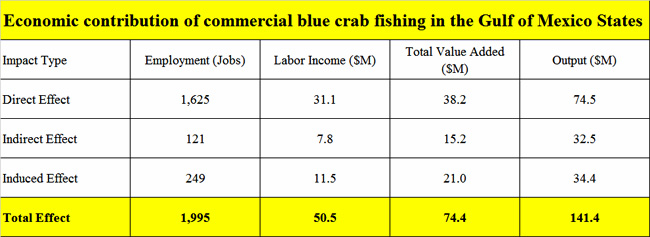
The annual commercial dockside values of blue crab in the Gulf of Mexico Region in 2015 reached $74.5 million, which was about 17% more than the average annual dockside values during the last five years. The total economic contribution of commercial blue crab fishing in 2015 amounted to $141.4 million (Figure 2). The blue crab commercial fishing created 1,995 jobs and generated labor income amounting to $50.5 million in the Gulf regional economy. The blue crab commercial fishing industry generates annual tax revenues for the Gulf States and the U.S. federal government. About $8.6 million were estimated to have been paid by households and businesses in 2015 to the federal government as social insurance tax, tax on production and imports, corporate profit tax, and personal income tax. The Gulf States were expected to have collected taxes from households and businesses in 2015 amounting to $4.2 million as social insurance tax, tax on production and imports, corporate profits tax, and personal tax.
Figure 3 shows the commercial landings of blue crabs from the Gulf of Mexico Region since 1990. During the last five years, the Gulf States supplied 32.3 % of the entire blue crab domestic landings averaging 52.5 million pounds and valued at $63.7 million annually. Louisiana is the largest producing state in the Gulf of Mexico, supplying more than 26.4% of all domestically-caught blue crabs, and 81.6% of all the blue crabs harvested in the Gulf of Mexico region.
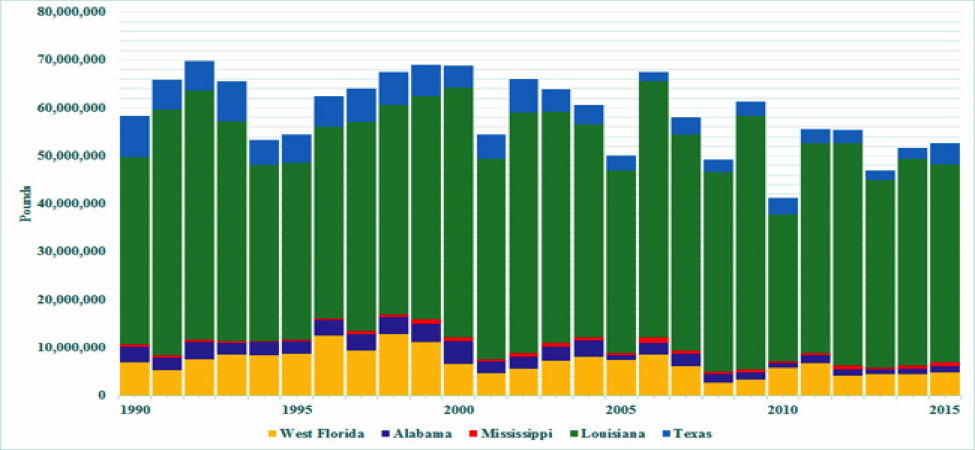
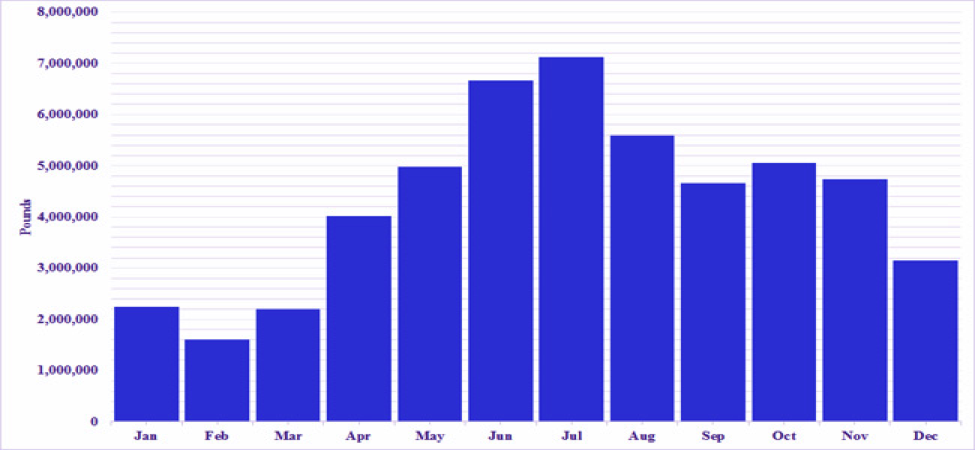
In 2015, the Gulf-wide commercial landings of blue crabs reached about 52.6 million pounds. This shellfish species was caught year-round with most of the landings occurring during the summer months (Figure 4). The declining commercial landings of blue crabs led to rising dockside values, especially during the last five years following the Deepwater Horizon oil spill in 2010 (Figure 5).
There are 4,309 fishing businesses, seafood processing plants, seafood and fish markets, and seafood restaurants registered in MarketMaker nationwide which harvest, process, sell and serve blue crabs in the United States. Click this LINK to view the search results online. The online database of blue crab businesses can be sorted by relevance, distance and alphabetically. You can also limit online searches by state, county, city or number of miles from a specified location, and type of business.
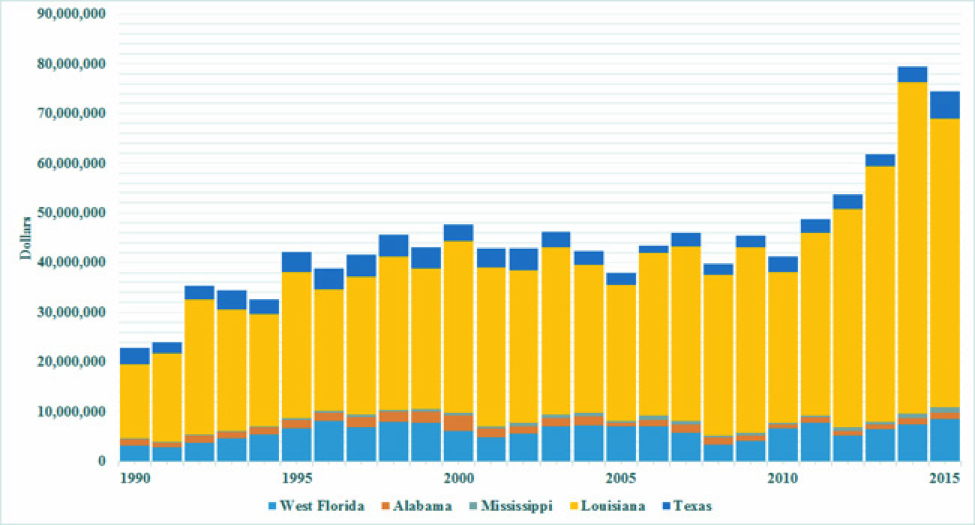
What is MarketMaker?
MarketMaker is the largest and most in-depth database of its kind featuring a diverse community of food-related businesses: buyers, farmers/ranchers, fisheries, farmers markets, processors/packers, wineries, restaurants, and more. MarketMaker provides simple yet powerful search tools to connect with others across the production and distribution chain (http://ms.foodmarketmaker.com/).
Where can you find Mississippi MarketMaker?
MarketMaker is located at http://ms.foodmarketmaker.com/.
Ask Siri or Cortana to search for “Mississippi MarketMaker” on your smart phone.
How do you register your food business in Mississippi MarketMaker?
Click Register and type your email address and a password in the spaces under Register. Be prepared to enter information (and pictures) about your business.
What are the benefits in registering your food business in Mississippi MarketMaker?
Producers register their businesses in MarketMaker because food buyers of all types access our database to find products and services to meet their specific needs. Through MarketMaker, producers can reach more buyers and more efficiently from profitable business alliances.
How do you search for your business profile in Mississippi MarketMaker?
Click Search and type the name of your business in the space under Search MarketMaker.
How do you update your business profile in Mississippi MarketMaker?
Click Register and then click UPDATE YOUR PROFILE. Type your email address and password in the spaces under Account Login. Be prepared to enter updated information (and pictures) about your business.
MarketMaker Training Workshops
This training workshop is available upon request by a group of 6-12 producers, extension agents, state regulatory agencies staff, and teachers. Each workshop will best fit the needs of the participants. Email Dr. Ben Posadas for details at ben.posadas@msstate.edu.
How do you search for local food businesses in Mississippi MarketMaker?
Click Search and type a keyword in the space under Search MarketMaker.
What is the Market Research tool of MarketMaker?
The MarketMaker research tool is an interactive mapping resource for identifying target markets, developing customized census profiles, and mapping food related businesses over demographic maps.
Where do you find the Market Research tool in MarketMaker?
Look for the Market Research section in MarketMaker and click Research your market now or Use previous version.